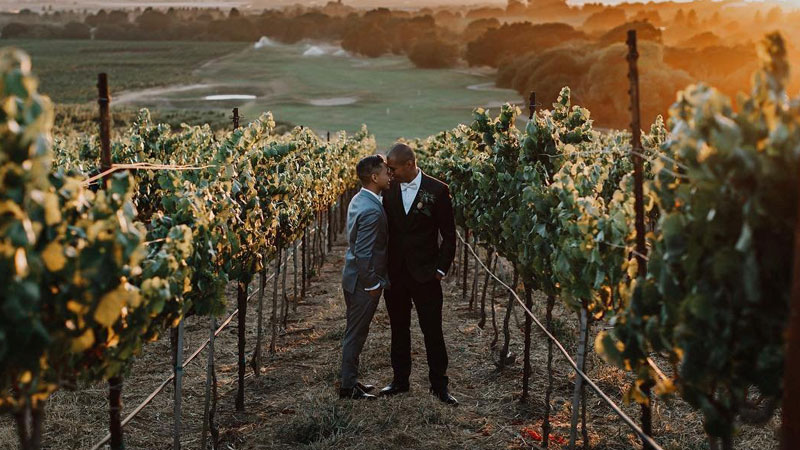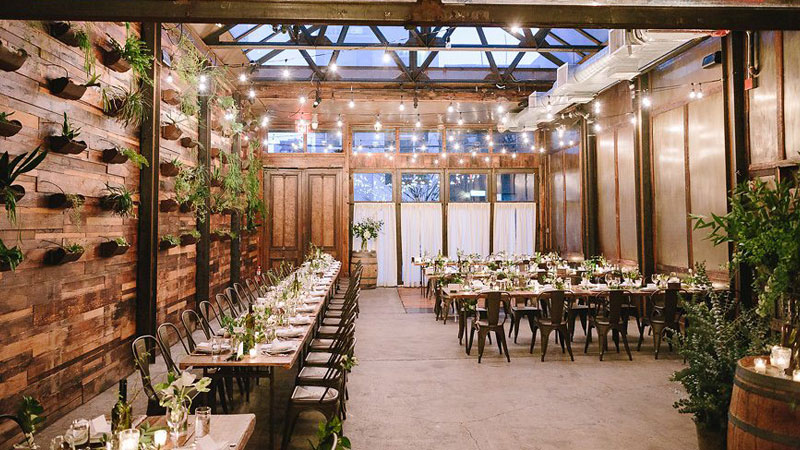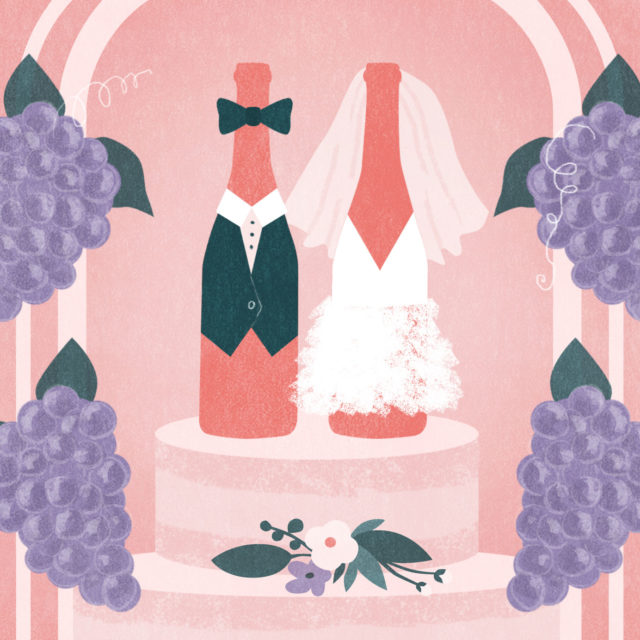The greatest bartending move of all time is reported in the New Testament. In the Gospel of John (2:1-11), Jesus is at a party in Cana, chilling with his disciples, when his mother tells him they’ve run out of wine. Lo and behold, he turns their water into wine.
What most people don’t realize, however, is this miracle occurred while the Messiah was at a wedding. That detail precipitates one of the most pervasive trends in present-day America: the winery wedding.
Over the last 20 years, as American beverage and wedding cultures have evolved, winery weddings have transformed from rarity to ubiquity, powered in part by those seeking Instagrammable backdrops for their big day. How did this whole cottage industry start? And if you’re hosting or attending a winery wedding, is it fair to expect the juice will be good?
“I suspect there have always been weddings at wineries as wineries have always had event spaces, hospitality houses,” says Charles Olken, author of the “Connoisseurs’ Guide to California Wine,” first published in 1980. “And that goes back as long as I’ve been in the business.”
His insight is useful because researching the history of winery weddings on the internet is extremely difficult. Any combination of search terms results in hundreds of pages of results for wineries advertising their gorgeous grounds.
On Brooklyn Winery’s slick website, for example, the fourth menu heading, after “Shop,” “Tours & Tastings,” and “Winemaking,” is “Weddings.” The lovely onsite wine bar and tasting room is not open to the public on most weekends because it’s too busy hosting wedding receptions that can pull in $50,000 per event. This urban facility in Williamsburg, Brooklyn, purports to be, “a uniquely chic space featuring our fully functioning winery as the understated backdrop to your wedding day.” Rather than touting its Chardonnay or Cabernet Franc, the site has a blog with tips on wedding color palettes (not, er, palates), recommended photographers, and “Wedding Shoe Styles We Love.”
The earliest mention of a winery wedding in The New York Times’ “Vows” section I can find is from 1999, when so-called master of the universe J. Todd Morley (“He doesn’t smoke cigars. He’s polite to waiters. He takes calls from old friends with low-paying jobs”) married fashion market director Dorrit Thomas (“She reads a lot, cries easily and always wears a gold bangle between her elbow and shoulder”). Their July wedding took place on a Southampton, N.Y., beach, but the reception for 340 was held “under a tent with a Balinese theme” at Channing Daughters Winery in Bridgehampton, N.Y.
One year later, The New York Times reported a wedding at Viansa Winery, a small, family-run place at the summit of the Sonoma Valley. From there, winery weddings became more and more commonplace. (Today, Viansa is a massive wedding factory, with meticulously landscaped, Tuscan-style grounds and an ivy-covered courtyard.)
“It became an accelerating trend really, because if you look at the demographics of the world, things really changed in the ’60s and ’70s. We became a much more middle-class nation. Which brought about the wine revolution, soccer, all kinds of progressive things post-World War II,” Olken says. “Meanwhile, weddings were becoming increasingly more expensive generally, people were becoming increasingly more secular, and they started wanting to hold their weddings in places other than churches.”
Enter wineries, one of the few picturesque, indoor-outdoor spaces with a large amount of manicured grounds. By early 2001, Wine Enthusiast was extolling how “the natural beauty of a vineyard is as romantic and elegant a setting as you can get.” Titled “Vows in the Vineyard,” the article included a list of top wedding wineries the country over as well as tips for securing your reservation (“get married on a weekday or on a date between November and March”).
By 2009, wedding publication The Knot started formally tracking winery weddings. The amount doubled nearly every year. As for The Times, it published 30 wedding announcements that specifically cited a winery as their location in 2018; it’s already published 14 more through the first half of 2019.

Interestingly, these weddings will probably not be held at a winery in America’s most famous wine region.
In Beverly Clark’s 1989 book “Planning a Wedding to Remember,” Napa wineries in particular are touted as a great location for your special day. “Many are old, steeped in tradition and make a beautiful setting for a unique wedding. Some wineries in California’s Napa Valley are known for the hot-air balloons which land at the winery in time for a champagne brunch,” Clark writes.
That same year, however, the Board of Supervisors of the County of Napa issued an ordinance that local agriculture must be protected from events that could deplete it. Though never specifically stated, that meant weddings. And so, aside from a few places that were grandfathered in (Charles Krug Winery, to name one), winery weddings in the county were strictly verboten forevermore.
“Why bring in Las Vegas to Napa?” wrote resident Beta Hyde in support of the ordinance in her letter to the editor of the Napa Valley Register. “When you examine other quality-oriented wine regions of the world, you’ll see that the greatest wine estates are closed to the public and yet they manage to sell their wines at high prices. I’d like to say it’s the quality and not a wedding party that is responsible for their success.”
If Napa has done a somewhat good job staving off weddings for the last two decades — admittedly, quite a few sneak by the ordinance — that just means couples have redirected their attentions to other wine-producing regions, like next-door neighbor Sonoma. According to legal firm IJ Action, Sonoma County hosted 3,000 winery weddings in 2013, injecting $101 million into the local economy. Other regions such as Texas Hill Country, the Charlottesville area of Virginia, the North Fork of Long Island, and New York’s Finger Lakes have also jumped on the trend.
“People like wineries because of the romance,” says Tambi Schweizer, the former tasting hall and wine club manager at Heron Hill Winery, which started holding weddings in 2000 and now does about 25 annually. “The couples want to get their picture in the barrel room. In front of the vineyard it always looks very romantic.”
Ah, yes, pictures. You can’t ignore the importance of Instagrammability in general, but especially at weddings.
“Whether you love wine or not, couples want that wow factor for their wedding more than anything else these days,” explains Ivy Jacobson, who served as digital editor of The Knot.
“They want their guests to say, ‘Wow, I’ve never seen that wedding before!’ They want beautiful pictures to be taken. That’s why unconventional venues like wineries are having a moment. It’s organized with social media in mind more than anything.”
The first time I attended a wedding at a winery was in the Finger Lakes, circa 2005. “How’s the wine here?” I naively asked my buddy, the groom. “Awful,” he responded. We both drank Brooklyn Lagers all night.
A couple of years later, at a wedding at a pastoral winery on the North Fork of Long Island, the bartender insisted I have a Dewar’s instead of the house Chardonnay. At many winery weddings, the bubbles for the toast are carted in from another producer.
Did wineries with bad wine pivot to become wedding venues? Or did the scourge of wedding receptions every weekend lead winery owners to not particularly care if their wine is great, so long as the event deposits keep rolling in?
There do seem to be some wineries that don’t even need to make wine, and exist merely to hold weddings —“Potemkin wineries,” Olken derisively calls them — but Olken doesn’t think good wine and a beautiful setting are mutually exclusive. “I think that’s a fallacy, that if you hold weddings, you have bad wine,” he says. “If you do it right, you can do both very well.”
The question is: Does anyone care?
Olken recalls attending a wedding a few years back at the well-regarded Thomas Fogarty Winery in the hills of the San Francisco Peninsula. It had lovely views of the vineyards, and the wine was delicious.
The kicker, however, was that the bride and groom didn’t just not drink that particular vineyard’s wine, they didn’t drink at all.
“It’s a very attractive place, which is why these wealthy kids chose it,” Olken says. “They didn’t choose it because of the wine; they couldn’t care less. So it doesn’t matter that that winery was a decent winery. All they care about is the optics.”
So do other couples, and that’s why this wedding winery industrial complex has sprung up in areas not exactly known for producing world-class wine, like, say, Brooklyn — where, admittedly, the grapes are trucked in from Long Island. Thus, maybe it’s not the wineries that are cynical. Maybe it’s the bride and groom. And maybe it’s always been that way.
Even in that initial Wine Enthusiast article from 2001, the magazine noted, “You might think that the people who get married at wineries must all be crazy about wine … most brides and grooms interviewed for this article said that an attractive outdoor location was their top criterion for a wedding or reception site.”
So if I’ve mostly had bad wine at winery weddings, maybe it was simply my bad luck that the couples getting married cared more about the setting, the romance, the potential for killer photos, than what their guests would be drinking all night. Hell, maybe I should be paying more attention to my friends’ weddings than focusing on how good or bad their wine is.

Now, certain wineries are finally starting to realize that having non-wine fans in for a raucous Saturday night might not actually benefit their businesses in the long term. Jim Nocek, owner of Anyela Vineyard in New York’s Finger Lakes, toys with putting an end to having wedding receptions on his estate. He had offered them since 2009, holding about 20 per year.
Initially, he thought it was nothing more than a smart business decision. Opening a winery is “capital intensive,” he tells me; his vineyard was planted in 2001 and he wasn’t even able to start earning a single dollar from it for another five years. Using his facilities for the most effective economic capacities was a good insurance measure.
“When you look at, certainly, the booking of an event for a certain amount of money, it’s a sure thing,” he says, “as opposed to ‘Is this going to be a good Saturday or a bad one?’”
As the years moved on, his wine became better regarded, and his winery and the Finger Lakes in general became more of a wine tourism destination, he began to question the need for weddings. He hated always having part of his winery blocked off on weekends for receptions.
“We were cannibalizing some of our regular Saturday business,” he explained. “And that concerned me a great deal. We were first a winery before anything else. That’s our core business.”
He had also learned that weddings aren’t always the massive cash cow that they seem to be to outsiders. There are all kinds of hidden costs and challenges, like setting up temporary seating, coordinating with caterers (few wineries have kitchens), and not annoying countryside neighbors with loud music. There’s countless headaches to deal with as well, including portable bathrooms getting flooded, and young, drunken guests mistreating the facilities.
With so few weekends during the summer, Nocek started thinking it would be better to focus on the true wine fans — those who might actually return to the vineyard every year — as opposed to uninterested, one-time reception guests. As of summer 2019, Anyela Vineyard is no longer hosting wedding receptions.
“Certainly part of the challenge is you have to identify what you’re about. You’re about selling wine,” Nocek explains. “So hopefully [the bride and groom] would like wine and their invitees would like wine and you’d sell more wine. But that’s not usually true and I think there was definitely a diversion from what we had initially wanted to do.”
Olken doesn’t own a winery, but he agrees with Nocek’s way of thinking.
“The argument has become that the wineries need the weddings to survive economically. But do they?” Olken asks. The U.S. has gone from around 6,000 wineries in 2009 to more than 10,000 today and growing, generating some $200 billion in revenue. “The failure rate of wineries is infinitesimal to the failure rate of pretty much all other businesses. They just don’t fail. You have to be an absolute idiot at winemaking and wine-selling to fail at it,” Olken says.
“We just don’t lose a lot of wineries. Weddings or not.”
